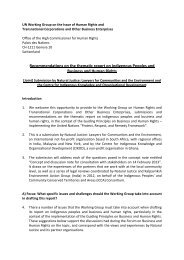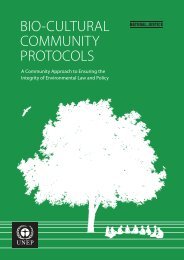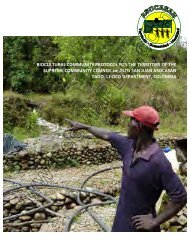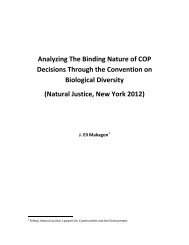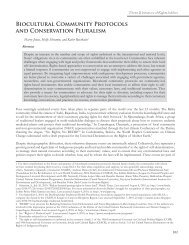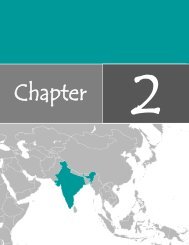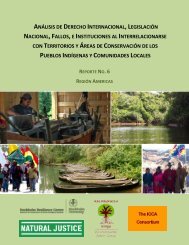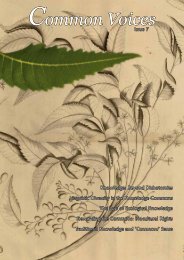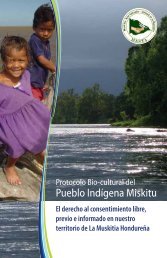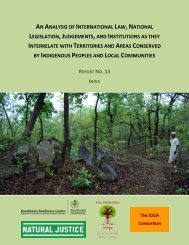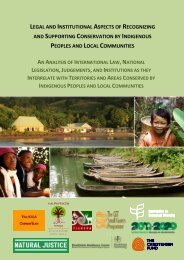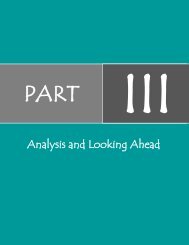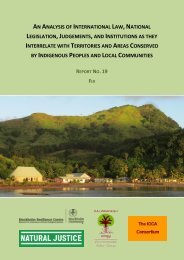Copy of bcp 18112011 English - Natural Justice
Copy of bcp 18112011 English - Natural Justice
Copy of bcp 18112011 English - Natural Justice
Create successful ePaper yourself
Turn your PDF publications into a flip-book with our unique Google optimized e-Paper software.
Prepared By:Banni Pashu Uchherak Maldhari Sangathan
The biocultural community protocol <strong>of</strong> maldharis <strong>of</strong> banni2. BIOCULTURAL PROTOCOL OF MALDHARI OF BANNI2We are Maldharis, pastoralists who live inBanni grasslands <strong>of</strong> Kachchh district in Gujarat,India. We have been the custodians <strong>of</strong> thebiodiversity rich Banni grassland ecosystemand have protected and nurtured it for over450 years. The Maldhari way <strong>of</strong> life has coevolvedwith the Banni ecosystem and ourindigenous livestock- the Banni buffalo,Kankrej Cattle, Sindhi Horse which areuniquely adapted to Banni; and has evolvedthrough a dynamic and complex interrelationshipbetween Maldharis and Banni.Maldharis, Banni Grassland and animalgenetic resources <strong>of</strong> Banni are mutually interdependentand any adverse impact on onenecessarily affects the wellbeing <strong>of</strong> others.This is Maldharis Bio-cultural Community ProtocolWe believe that nature has entrusted us with the responsibility to protect Banni andthe right to practice our traditional way <strong>of</strong> life in the Banni and through this bioculturalcommunity protocol we call on the government to respect and affirm thisright.In Maldharis bio-cultural community protocol we clearly state who we are, wherewe live, our relationship to Banni and our animals, our rights to land, our breeds andassociated traditional knowledge and our duties to protect this eco-system. Thisprotocol has been developed through a number <strong>of</strong> meetings held amongst Maldhariscommunities representing different Maldhari hamlets in Banni (refer to Annexure 1for a list <strong>of</strong> protocol related meetings held in East, Central and West Banni) and hasbeen approved by the 965 members <strong>of</strong> the Banni Pashu Uccherak MaldhariSangathan (Banni Breeders Association) who represent different Panchayats inBanni.
The biocultural community protocol <strong>of</strong> maldharis <strong>of</strong> banni3. WHO WE ARE:3We, Maldharis, are spread over 48 hamletsthat are organized into 19 panchayats (referto Annexure 2 for a list <strong>of</strong> 19 panchayats). Ourpopulation is around 17,000 with 90% beingMuslim and 10% being Hindu (refer toAnnexure 3 for a list <strong>of</strong> different castes <strong>of</strong>Maldhari Muslim and Hindu communities-Maldhari hamlets are organized along castelines). We speak Kachchhi in Sindhi dialect.Both the Muslim and Hindu communitieskeep livestock while the Hindu Meghwals,and Vadha Koli have a rich history <strong>of</strong> beautifulembroidery, leatherwork, woodcarving andbuilding <strong>of</strong> bhungas (the traditional circularmud houses <strong>of</strong> the Maldharis). Women <strong>of</strong>pastoral communities also prepare exquisiteembroidery. Both the Hindus and theMuslims have strong ties with each other andthe Muslims in solidarity with the Hindus donot eat beef. Historically the Muslimsprovided milk and ghee to the HinduMeghwals who in turn provided the Muslimswith leather shoes, saddles, reins, satchels forcarrying water and helped build theirbhungas.There are different stories <strong>of</strong> how we came tolive in the Banni. The Banni was bequeathedas a commons by the erstwhile Maharao toour ancestors who were nomadic pastoralistsoriginating from the Sindh region in Pakistan.It was given to our custody with the conditionthat we protect the grassland ecosystem andshare it communally for grazing and not use itfor agriculture or divide it up into privateproperty. We have since used Banni only as apastureland and discouraged any farming orprivate land holding within it.
The biocultural community protocol <strong>of</strong> maldharis <strong>of</strong> banni4We have the title deed from the Maharao thatbequeaths this land to us. Under the rulership<strong>of</strong> Jadejas, there was a system <strong>of</strong> Grasdharseach administering one <strong>of</strong> the 23 subecoregions<strong>of</strong> Kachchh. We have tax receiptsas evidence that we historically paid pancheri(grazing tax) to the Grasdhars in exchange forthe right to graze our animals in Banni. AfterIndian Independence in 1947, Kachchh became apart <strong>of</strong> the Bombay presidency in 1953 and Bannicontinued to be used as a grassland under thecontrol <strong>of</strong> the Revenue Department without anyallocation <strong>of</strong> private land holding.Title deed from Maharao Shree <strong>of</strong> Kutch & tax receipts as evidence that we historically paidpancheri (grazing tax)
The biocultural community protocol <strong>of</strong> maldharis <strong>of</strong> banniOur elders have told us that in 1736, an army from Sindh led by Khaloda Mohammed Mirinvaded Kachchh. Our ancestors were asked by the Maharaja Radheshua-ji <strong>of</strong> Kachchh t<strong>of</strong>ight with his armies and defend the land from invaders. Though we lost many lives andsuffered much in the ensuing battle, the Maharaja was, with our help, victorious. Toreward our loyalty and valour the Maharaja gave the Maldharis title to the Banni. As wewere pastoralists the Maharaja also decreed that the grasslands should not be used foragriculture.-From an interview with one <strong>of</strong> the elders <strong>of</strong> Meghwal Hindus5THE BANNI GRASSLAND0The Banni region, situated at 23 19'N to0 0 023 52'N to 68 56'E to70 32'E is a semi-aridgrassland ecosystem spread over 2600 sqkilometres. It was considered the secondlargest grassland ecosystem in Asia and oncehome to over 40 different species <strong>of</strong> grass(refer to Annexure 4 for a list <strong>of</strong> 25 differentspecies <strong>of</strong> grass that were identified byMaldhari elders and outcomes <strong>of</strong> theparticipatory grassland mapping process).Banni region was created from the sea as aresult <strong>of</strong> tectonic activities and its fertility wasthe result <strong>of</strong> alluvial deposits from the riversthat flowed from the Bhuj mainland andended in the Greater Rann <strong>of</strong> Kachchh. Theclimate <strong>of</strong> Banni is arid with a hightemperature in the summer months that go0 0up to a maximum <strong>of</strong> 48 C -50 C during May-June and a low winter temperature that goes0 0down to 5 C 8 C during December-January.The average annual rainfall, occurringthrough Southwest monsoon between themonths <strong>of</strong> June to September, is a very low <strong>of</strong>317mm with a coefficient <strong>of</strong> variation <strong>of</strong> 65%.Recurrent droughts, 3 year drought <strong>of</strong> a 5 yearcycle, is a very common phenomenon inBanni. However in last five years there hasbeen little increase and regularity in rainfall inBanni region.
The biocultural community protocol <strong>of</strong> maldharis <strong>of</strong> banni6Banni has a rich avianpopulation <strong>of</strong> more than 200species <strong>of</strong> resident andmigratory birds. Banniwildlife includes the blue bull,chinkara, Indian hare, jackal,the grey wolf, caracal, hyenaand jungle cat. Reptilesinclude the spiny tailedlizard,common monitorlizard, vipers, sand snakes andblind snakes.Legend has it that a great sage Dhoramnath meditated, on his head, for 12 longyears atop the mighty Dhinodar mountain <strong>of</strong> Kachchh. The Gods blessed him withan ability to burn and lay waste whatever came in the line <strong>of</strong> his sight when heopened his eyes after meditation. Before opening his eyes he asked his disciple toturn his head in the direction where he would cause the least harm to livingbeings. His disciple turned Dhoramnath's head in the north towards the shallowsea and Rann (salt desert). When the sage opened his eyes, he burned the shallowsea and the Rann away, leaving behind fertile land on which rich grasses begangrow. Pastoralists from as far away as Baluch and Haleb in Afghanistan camein search <strong>of</strong> this grassland that they called Banni, derived from the Kachchhiword Bannai meaning 'that which was created' leading to the saying “rann sebanni hui” (the Banni was created from the salt d e s e r t ) .
The biocultural community protocol <strong>of</strong> maldharis <strong>of</strong> banni4. MALDHARI WAY OF LIFE7Our way <strong>of</strong> life isn't subsistence oriented andour animals and animal products are producedfor the agrarian market. We have bred theBanni buffalo that is uniquely adapted to Bannigrassland ecosystem and produces high yields<strong>of</strong> milk with very low external inputs. TheBanni buffalo is disease resistant, can handlewater stress conditions and has a strongconstitution. We also breed the Kankrej cattlethat we sell or loan as sturdy and resilientdraught animals to farmers all over Kutch andSaurashtra. Every year some <strong>of</strong> us walkhundreds <strong>of</strong> kilometres delivering draughtanimals to farmers in different parts <strong>of</strong> Gujarat who pay us in instalments over a period <strong>of</strong> threeyears. We also breed the Kutchi goat, the Kutchi camel and Pathanwadi, Dumba sheep and SindhiHorse.“Banni grassland is our home. Even when there have beendroughts for many years, leaving us no choice but tosurvive by eating bark from trees and seeds <strong>of</strong> grasses, wehave never left this area, though we migratedtemporarily to survive our animals. Though our peoplehave suffered much misfortune here, we have nevermoved.”
The biocultural community protocol <strong>of</strong> maldharis <strong>of</strong> banni8We sell our animals to the livestock innkeepers and farmers and use services <strong>of</strong> traditional expertscalled bhagiyas who are trusted by both the buyer and the seller. The method <strong>of</strong> bargaininginvolves the bhagiya being used as an intermediary where the seller covers his and the bhagiya'shand with a kerchief and then indicates using his covered fingers the selling price <strong>of</strong> the animal.The same process is repeated between the bhagiya and the potential buyer, where the buyerindicates the price he is willing to pay. The bhagiya indicates this to the seller under the kerchief,thus beginning the process <strong>of</strong> negotiation. The entire process is carried out in a manner that onlythe seller, the buyer and the bhagiya are aware <strong>of</strong> the price that is being negotiated. This is ourtraditional system <strong>of</strong> sale <strong>of</strong> livestock that ensures that the price <strong>of</strong> livestock is not entirelydetermined by the market but also in accordance with the value the seller and the buyer put on aparticular animal.We have a deep understanding <strong>of</strong> Banniecosystem and an extensive knowledge <strong>of</strong> thedifferent grasses that grow here. We categorizegrazing patches based on soil types, size,distance from water bodies and villages,periodicity and quality <strong>of</strong> drinking water foranimals, grass, shrubs, tree cover and diversityand wind. Decisions on grazing areas androutes are based on the condition <strong>of</strong> the grazingarea, grass cover and availability <strong>of</strong> water andcare is taken to prevent overgrazing and toallow grasses to reach maturity.For instance, after a good monsoon, animals <strong>of</strong>Bhitara villages go to Gaar, animals <strong>of</strong> Bhagadiago to Gugardui, similarly animals <strong>of</strong> Sarada goto Thala for grazing. Because <strong>of</strong> the high spatialvariability in rainfall, villages that receive raindo not restrict entry <strong>of</strong> pastoralists from othervillages into their grazing areas since sharing <strong>of</strong>resources is our value.
The biocultural community protocol <strong>of</strong> maldharis <strong>of</strong> banniFood, shelter and water is provided to themthus affirming a long tradition <strong>of</strong> hospitalityand mutual inter-dependence in an aridregion with a harsh terrain that requirescooperation between the communities thatlive there.9There is a strong tradition <strong>of</strong> trust betweenthe different Maldhari villages and whensomeone's animal gets lost and ends up in adifferent herd, the pastoralist whose herd theanimal joins, cares for the animal like it is hisown and returns it to its owner even if theowner manages to find it many months later.Despite the fact that our herds grazeunaccompanied at night and our animalsfetch high prices in the open market, theyrarely get stolen which is evidence <strong>of</strong> thecohesiveness and integrity <strong>of</strong> Maldharicommunities in Banni. We have customaryrules for grazing and management <strong>of</strong> thecommon grazing areas that are based oninterdependence between communities anda deep understanding <strong>of</strong> ecosystem. It isthrough the observance <strong>of</strong> these rules, wehave been able to protect Banni and thrive init for the last 450 years.
The biocultural community protocol <strong>of</strong> maldharis <strong>of</strong> banni5. THE BANNI BUFFALO10We Maldharis have developed the unique We maintain the original bloodline <strong>of</strong> BanniBanni buffalo, which is specifically adapted buffalo through the dam and every buffaloto Banni grasslands. The Banni buffalo has within the same bloodline carries the samebecome a dominant livestock over the last name. Banni buffalos form close bonds withcouple <strong>of</strong> decades as a result <strong>of</strong> the their owners and usually respond whenwidespread loss <strong>of</strong> our Kankrej cattle due to called by their name. For e.g. Chhalli is thetheir inability to digest the toxic pods <strong>of</strong> name <strong>of</strong> a bloodline that stretches back a 108Prosopis Juliflora, a highly invasive alien years and this bloodline is renowned for itsspecies initially propagated by the capacity to produce high milk yields.government as a part <strong>of</strong> an <strong>of</strong>ficial policy <strong>of</strong>greening Banni. The Banni buffalo isunaffected by Prosopis Juliflora and thebuffalo has unique qualities <strong>of</strong> adaptation,like the ability to survive water stressconditions, to cover long distances duringperiods <strong>of</strong> drought and disease resistance.The Banni buffalo has a typical quality <strong>of</strong>night grazing. The herd covers a grazingdistance <strong>of</strong> 8-10 kilometres in monsoonand upto 15 kilometres in summer. Herds <strong>of</strong>Banni buffalo are led by the lead buffalothat they follow staying within earshot <strong>of</strong>the special sound <strong>of</strong> a bell around everylead buffalo's neck. A herd that usuallycomprises <strong>of</strong> 40-50 animals and sometimesextends to 90-100 animals departs forgrazing in the evening after second milkingand returns at dawn every morning.Despite the multitude <strong>of</strong> herds, buffalosrarely get lost or mixed in different herdsand invariably follow the lead buffalo backto their respective pens at dawn.The Banni BuffaloIt is only Banni grasslands andMaldharis who can create the Bannibuffalo. If a buffalo is raised outsideBanni, but has not grazed Bannigrasses and has not been raised byMaldharis according to our traditionalpractices, it cannot be called a Bannibuffalo.
The biocultural community protocol <strong>of</strong> maldharis <strong>of</strong> banni11We choose our breeding bulls very carefullyand the criteria we base it on include its dam'smilk yield, strength, ability to withstandstressful conditions and disease resistance. Wealso prefer certain physiological features thatinclude coiled horns, short but sturdy legs,convex forehead and white tail hairs. Eachbreeding bull is limited to three services perday and breeding bulls are exchanged betweennearby villages every 3-4 years to avoidinbreeding.The Indian Council <strong>of</strong> Agricultural Researchrecently recognized the Banni buffalo as the1 1 t h b u f f a l o b r e e d i nIndia.(INDIA_BUFFALO_0400_BANNI_01011)Research has shown that the Banni buffalo iscapable <strong>of</strong> astonishingly high milk yields withan average <strong>of</strong> 2857 litres <strong>of</strong> milk over the yearwith high fat content. The grasses <strong>of</strong> Bannienables the Banni buffalo to calve at 3 years <strong>of</strong>age and achieve peak milk yields within anastonishing 38 days after calving (refer toAnnexure 5 for the table <strong>of</strong> performance <strong>of</strong> theBanni buffalo)The Maldharis hold their animals in high regard.Some <strong>of</strong> us take our shoes <strong>of</strong>f before we enter theplace where our animals lie. Historically themeasure <strong>of</strong> a man was based on different animalshe kept. A Maldhari who had a good pedigree pureanimals and expert in traditional knowledge wasknown as 'bhagiya'- he who is lucky withanimals.
The biocultural community protocol <strong>of</strong> maldharis <strong>of</strong> banni6. OUR KANKREJ CATTLE12Earlier we used to raise Kankrej cattle,commonly called Vadhiyari. During earlytimes, through barter system, we used to getgrains from farmers by giving them cow milkand ghee. This cattle breed is also famous forits draught capacity, amongst the farmers <strong>of</strong>Kutch and Saurashtra, having savai chal,(meaning back leg reaches further thanwhere front leg was landed) which gives anopportunity to cover more distance in lesstime. Till today, we Maldharis <strong>of</strong> Banni, everyyear, sell 8-10 thousands Kankrej bullock inKutch and Saurashtra.This dual purpose animal is adapted to theharsh climatic conditions <strong>of</strong> Kutch and hashigh milk yield capacity with good fatcontent. This cattle is strongly built andfamous for its beautiful look with large halfmoon shaped horns. Average milk yield <strong>of</strong>pure Kankrej cattle is 6-8 lts a day whilelactation yield is around 1800-2000 lts. Thisanimal has the capacity to move longdistance, therefore, able to migrate todifferent parts <strong>of</strong> Gujarat during droughtyears.In last few decades, due to man made andecological hazards, the number <strong>of</strong> Kankrejcattle in Banni has been reduced drasticallyfrom 50000 in late sixties to hardly 15000-17000 at present. Still some Maldharis <strong>of</strong>Banni conserve and survive this animal breedby fighting against all odds.
The biocultural community protocol <strong>of</strong> maldharis <strong>of</strong> banni7. OUR TRADITIONAL KNOWLEDGE13We have a rich traditional knowledge thatranges from how we care for our animals toethno-veterinary knowledge to methods <strong>of</strong>water harvesting and conservation andsustainable use <strong>of</strong> Banni grasslands.Through our traditional knowledge relatingto our breeds we have, over centuries, beenable to develop particular characteristicsthat enable the animals to survive and thrivein the difficult conditions <strong>of</strong> Banni, whilstmaintaining high yields. Our knowledgeextends to what we feed our animals, forexample: we give 4-5 kg <strong>of</strong> feed concentrateto the breeding bull per day and sometimesup to 8 kg <strong>of</strong> feed concentrate depending onthe number <strong>of</strong> services it provides; we raisethe bull in a way that allows them to startservicing at 2.53 years <strong>of</strong> age; we feed ghee,mustard oil and unrefined cane sugar(jaggery) to the calves to strengthen themand we feed the breeding bulls eggs andghee for energy. The milk that our animalsproduce is entirely organic with no chemicaladditives.Many a times we treat our animals using ourtraditional medicine. Whilst there areveterinary hospitals outside Banni they aredifficult to access and sometimes expensive.We therefore also rely on our traditionalforms <strong>of</strong> medicine for our animals. Forexample our knowledge includes techniquesfor safe delivery <strong>of</strong> calves, treatment <strong>of</strong> sickanimals using herbs and grasses <strong>of</strong> Banni andproviding our animals certain foods to healthem. We take pride in this knowledge andwant to preserve it for our futuregenerations.“The skills and knowledge we have <strong>of</strong> our livestock was given to us by God and if we sellthis knowledge then this goes against what which we have been given.”
The biocultural community protocol <strong>of</strong> maldharis <strong>of</strong> banni14Besides our rich understanding <strong>of</strong> thedifferent grasses in Banni and the grazingpatterns we have used to conserve andsustainably use the grassland for centuries,we also have our own unique waterharvesting techniques that enable us tosurvive the harsh Kachchh summers. Duringthe dry season we have a tradition <strong>of</strong> buildingtemporary wells called virdas that becomethe source <strong>of</strong> water for both humans andanimals.The digging <strong>of</strong> a virda is a communal activityand is done by the men <strong>of</strong> the entire village.Usually the hamlet where the virda is dughosts all the men with food, water and tea tosustain them throughout the day. The virda isusually dug in the summer months after ajheel (a water catchment area or pond) hasdried up but there is still water in the groundin the area <strong>of</strong> the jheel. The virda is a shallowwell that is dug and lined with logs <strong>of</strong> woodand Banni grasses. The wood prevents thewell from collapsing and the grasses act asnatural filters cleaning the sediments fromthe water that now flows into the virda fromthe sides.OUR SYSTEM OF GOVERNANCE AND DECISION MAKING:We live in hamlets, which are divided alongcaste lines. Hamlets usually consist <strong>of</strong>extended families and our elders makedecisions within the hamlets. A few hamletsconstitute a village and the panchayat is thegoverning body at village level. There are 48Maldhari hamlets in Banni and they areorganized under 19 panchayats. Everypanchayat has 5-8 elected representativesfrom village level who hold <strong>of</strong>fice for a fixedterm. Maldhari panchayats have united at aregional level as the Banni PanchayatParishad (the Banni Panchayat Association)which is the regional body addressing theissue <strong>of</strong> continued usufruct rights <strong>of</strong>Maldharis to Banni and ensuring thecommunal status <strong>of</strong> the Banni grasslands.Decisions regarding the certification andmarketing <strong>of</strong> milk, the Banni buffalo, theKankrej cattle and other related issues aretaken by the Banni Pashu Uccherak MaldhariSangathan (Banni Breeders Association)which has 965 members and an executive <strong>of</strong>21 members, 19 <strong>of</strong> whom represent differentMaldhari panchayats and 2 from theMeghwal community.
The biocultural community protocol <strong>of</strong> maldharis <strong>of</strong> banni8. PRIOR INFORMED CONSENT AND BENEFIT SHARING:15We collectively own our animal geneticresources and the associated traditionalknowledge relating to breeding and ethnoveterinarypractices. We have a distinct andrecognizable culture that is linked Banni andour animals and we, therefore, ask to beinvolved all decisions that the governmentmakes concerning Banni or our livestock.We request that our Banni PanchayatParishad and the Banni Pashu UccherakMaldhari Sangathan be consulted and theirfree and prior informed consent is takenwhenever decisions are made by externalparties that may affect our livelihoods orrelate to the access and use <strong>of</strong> our breeds andassociated traditional knowledge. We also askthe government to take into account our viewsregarding breeding policies for this region.When researchers or commercial interests seekaccess to our animal genetic resources and /orassociated traditional knowledge we wish to beconsulted, provided with all relevantinformation and permitted time in which tomake an informed decision. In the cases that wedo grant access to our animal genetic resourcesor associated traditional knowledge, we havethe right to negotiate a benefit sharingagreement based on mutually agreed terms.9. OUR CHALLENGES:Maldhari way <strong>of</strong> life is currently facing significant challenges- we believe that any threat to theMaldharis is also a threat to Banni grassland that we have conserved for centuries and to the uniquebreeds that we have developed. Our challenges include:9.1 Threats to our settlement and usufruct rights in the BanniWe have, for generations, led a semi settled in Banni as we have done for centuries. Whenlifestyle and lived in hamlets in Banni. We do Banni grasslands were declared a protectednot hold any land titles for our houses but we forest in 1955 our existing settlement rightshave been paying a house tax. Our hamlets should have been formally recognized and theyhave government infrastructure including were not. Currently there is a confusionpanchayat <strong>of</strong>fice, schools, water tanks, regarding the status <strong>of</strong> Banni, which continuespipelines and roads, though we have no land to be under the administrative control <strong>of</strong> thetitles. The recent division <strong>of</strong> Banni into 19 Revenue Department like it was prior to 1955,panchayats was undertaken without the even though it is classified as a protected forestdemarcation <strong>of</strong> village boundaries. We feel under the formal jurisdiction <strong>of</strong> the Forestinsecure about our rights to continue to live Department.9.2 Threats to Banni commonsWe are concerned about the insecurity thatstems from a lack <strong>of</strong> title deeds to ourhouses and the consequent inability to usethese title deeds as guarantees for loans orbail. We feel that this insecurity will lead tosome community members demanding thatBanni be divided into private land holdings thateach land holder can use or sell as he deems fit.This would lead to the destruction <strong>of</strong> anecologically sustainable way <strong>of</strong> life that wehave practiced for centuries and will result in abreakdown <strong>of</strong> the mutual trust and sharing
The biocultural community protocol <strong>of</strong> maldharis <strong>of</strong> banni16between Maldhari communities. In stressfultimes such as this, our elders have issued a callto the community members and thegovernment, saying 'Banni ko Banni rahenedo' meaning leave Banni as it was, as a commonland for pastoralists and their animals andrecognize our customary rights to live and grazeour animals in Banni.9.3 Threats from invasive alien speciesWe are anxious about the increasing spread<strong>of</strong> the invasive alien species ProsopisJuliflorathat is rapidly taking over the grassland anddestroying all the grasses. Prosopis Juliflorawas introduced by the Forest Departmentwithout consulting Maldharis as a part <strong>of</strong>their greening campaign. Instead <strong>of</strong> greeningBanni, this exotic plant has destroyed thegrasses by sucking up all the water, killed ourKankrej cattle, which graze on its toxic pods,and has taken over vast sections <strong>of</strong> Banniradically unbalancing the grasslandecosystem. The indigenous variety <strong>of</strong> thesame species that we call 'desi babul' andother indigenous shrubs and plant speciesare being slowly lost due to the onslaught <strong>of</strong>Prosopis Juliflora. Four years ago we werepermitted by the Forest Department to cutdown Prosopis Juliflora and use it to makeand sell charcoal as a part <strong>of</strong> a strategy to limit itsspread. Last year, the permission was deniedand instead the Forest Department is fencing <strong>of</strong>flarge sections <strong>of</strong> Banni, most <strong>of</strong> the timeswithout consulting Panchayats and itsrepresentatives, in an attempt to eliminateProsopis Juliflora and replant the traditionalgrasses. These fences have blocked ourtraditional grazing routes and we have lost some<strong>of</strong> our buffalos, which have fallen into the deeppits that have been dug around the fences. Atthe same time we have created our own grazingpatches where we have revived the rich Bannigrasses by eliminating Prosopis Juliflora. Wewould rather demand that the ForestDepartment rely on the traditional knowledgeand experience <strong>of</strong> Maldharis to revive Banniinstead <strong>of</strong> fencing <strong>of</strong>f portions <strong>of</strong> it to solve aproblem that they have created.
9.4 Threats from the damming <strong>of</strong> rivers flowing into the BanniHistorically a number <strong>of</strong> rivers such as theNara, Bhurud, Bhukhi, Nirona, Kaila, Khari,Kaswati, etc. flowed into Banni from Bhujridge reducing the salinity and watering therich grasslands. But over the last few decades9.5 Threats from chemical industries bordering the BanniWe have found water in some <strong>of</strong> the pondstowards the edge <strong>of</strong> Banni toxic. Recently welost two buffalos that drowned in one <strong>of</strong>these ponds- something highly unlikely sincebuffalos are natural swimmers. Ourconclusion based on the colour and smell <strong>of</strong>the water is that the buffalos drowned as aresult <strong>of</strong> being poisoned by the effluentsreleased into the water by chemicalindustries located along the border <strong>of</strong> Banni.We have noticed that these industries releasetheir effluents into the water when the water9.6 Threats resulting from the confiscation <strong>of</strong> our livestockthese rivers have been dammed resulting inwater shortages in Banni and affecting thegrassland ecosystem due to increase <strong>of</strong> salinityinthis region.levels rise after the rains. This toxic water flowsinto Banni causing grave damage to its flora,fauna and our livestock and posing a health riskto Maldharis. We are concerned about thepermits being given to toxic chemical industriesby the Government <strong>of</strong> Gujarat to set up theiroperations in the Rann <strong>of</strong> Kachchh that bordersthe Banni on the assumption that this area isuninhabited. The discharge <strong>of</strong> industrialeffluents into Banni has begun to pose a seriousthreat to all who live in it.The police have stopped us on a number <strong>of</strong>occasions when we take our cattle to themarket on the suspicion that we are taking thecattle to slaughterhouse. The sale <strong>of</strong> cattle forbeef is prohibited in Gujarat and we are falselyaccused <strong>of</strong> selling cattle for slaughter becausewe are Muslims. The Muslim Maldharis <strong>of</strong>Banni have traditionally prohibited theslaughter <strong>of</strong> cattle and the consumption <strong>of</strong>beef in solidarity with their Hindu neighbours.In Banni we have a rich tradition <strong>of</strong> communalharmony and syncretism. We are concernedabout the underlying prejudice that hampersus from carrying on our traditional practices <strong>of</strong> sale and loan <strong>of</strong> draught cattle to farmers <strong>of</strong> Kutchand Saurashtra with whom we have had a long-standing history <strong>of</strong> trade.17
The biocultural community protocol <strong>of</strong> maldharis <strong>of</strong> banni10. OUR RIGHTS UNDER INDIAN LAWS AND POLICIES:18A. The Scheduled Tribes and Other Traditional Forest Dwellers (Recognition <strong>of</strong> Forest Rights)Act 2006 and the Scheduled Tribes and Other Traditional Forest Dwellers (Recognition <strong>of</strong>Forest Rights) Rules 2008 (hereafter referred to as the Forest Rights Act and Rules)Maldharis have preexisting pasturage rights to Banni that directly result from thebequeathing <strong>of</strong> this land to us by the erstwhile Maharao <strong>of</strong> Kachchh. Even if these preexistingrights have not been recorded when Banni grasslands were declared a protectedforest in 1955 under the Indian Forest Act <strong>of</strong> 1927, the Forest Rights Act and Rulesrecognize the rights <strong>of</strong> pastoralists to forestland. The Forest Rights Act provides Maldhariswith the opportunity <strong>of</strong> getting previously unrecorded rights recognized through theprocess set out in the Forest Rights Rules.The right <strong>of</strong> Maldhari community as a whole to use Banni and to safeguard it is recognizedunder the Forest Rights Act. The Act grants us the right to use the forest and bestows on usthe duty to conserve and care for it. The Forest Rights Act applies not only to forestdwelling Scheduled Tribes but also other 'traditional forest dwellers' who are dependenton the forest to meet their basic needs. Maldharis fall under the category <strong>of</strong> other'traditional forest dwellers' and as per the Act we can establish that we have resided inand been dependent on Banni for the last 75 years prior to 13-12-2005.The Act introduces the concept <strong>of</strong> 'community forest resources' and 'community forestrights' . The Act in Section 2(a) defines 'community forest resources' to mean 'customarycommon forest land within the traditional or customary boundaries <strong>of</strong> the village orseasonal use <strong>of</strong> landscape in the case <strong>of</strong> pastoral communities, including reserved forests,protected forests and protected areas such as Sanctuaries and National Parks to whichthe community had traditional access'. Rule 31 (3) <strong>of</strong> the Forest Rights Rules provides thatevidence <strong>of</strong> traditional access rights can be established by showing: community rightssuch as Nistar by whatever name called, traditional grazing grounds, sources <strong>of</strong> water forlivestock use, water conservation structures, sacred trees, groves, ponds, burial groundsetc.The Forest Rights Act under Chapter II provides 13 classes <strong>of</strong> forest rights forcommunities. Of these 13 classes <strong>of</strong> rights, the Maldharis claim the following:See generally 'Legal Opinion on Pastoral Tenure Rights- In Banni region <strong>of</strong> Kutch, Gujarat',by Adv. Sanjay Upadhyay, available with Sahjeevan, Bhuj, Gujarat1. Other community rights <strong>of</strong> uses or entitlements such as fish and other products<strong>of</strong> water bodies,grazing (both settled or transhumant), honey, Gum, Charcoal,and traditional seasonal resource access <strong>of</strong> nomadic or pastoralist communities;2. Community rights such as nistar, by whatever name called, including those usedin erstwhile Princely States, Zamindari or such intermediary regimes;
The biocultural community protocol <strong>of</strong> maldharis <strong>of</strong> banni193. Right to protect, regenerate or conserve or manage any community forestresource which they have been traditionally protecting and conserving forsustainable use;4. Right <strong>of</strong> access to biodiversity and community right to intellectual property andtraditional knowledge related to biodiversity and cultural diversity;5. Any other traditional right customarily enjoyed by forest dwelling, ScheduledTribes or other traditional forest dwellers, as the case may be, which are notmentioned in clauses (a) to (k) but excludes the right <strong>of</strong> hunting or trapping orextracting a part <strong>of</strong> the body <strong>of</strong> any species <strong>of</strong> wild animal;B. The Forest Conservation Act, 1980In 1955 Banni grassland was notified as a 'protected forest' under the Indian Forest Act <strong>of</strong>1927. Any use <strong>of</strong> Banni therefore for a non-forest purpose would require the permission<strong>of</strong> the Central Government under the Forest Conservation Act, 1980. Such anunderstanding was affirmed by the Supreme Court in the T.N. Godavarman case, whichstated that a non-forest activity could be undertaken on any forestland only with thepermission <strong>of</strong> the Central Government.The Government <strong>of</strong> Gujarat therefore cannot lease any part <strong>of</strong> Banni for industrial use bythe chemical companies without the consent <strong>of</strong> the Central GovernmentC. The Biological Diversity Act <strong>of</strong> 2002 and the Biological Diversity Rules <strong>of</strong> 2004The Biological Diversity Act <strong>of</strong> 2002, in its efforts to fulfil India's commitments under theConvention on Biological Diversity provides, for the conservation <strong>of</strong> biological diversity,sustainable use <strong>of</strong> its components and the fair and equitable sharing <strong>of</strong> benefits arisingfrom the use <strong>of</strong> such biological diversity and associated traditional knowledge. TheBiological Diversity Act sets up the National Biodiversity Authority (NBA) and theBiological Diversity Rules <strong>of</strong> 2004 lists the functions <strong>of</strong> the NBA as including regulatingaccess to biological resources and associated traditional knowledge for commercial andresearch purposes. The NBA is also empowered to advise the Central Government on anymatter relating to the conservation and sustainable use <strong>of</strong> biodiversity and associatedtraditional knowledge and the fair and equitable sharing <strong>of</strong> benefits arising from theutilization <strong>of</strong> biological resources and associated traditional knowledge.The Biological Diversity Act, among other things, requires the Central Government underSection 36 to promote the conservation and sustainable use <strong>of</strong> biological diversitythrough in-situ conservation and minimize the adverse effects on biological diversity <strong>of</strong>any project undertaken through environmental impact assessments that includes publicparticipation. The Central Government is tasked with ensuring respect and protection <strong>of</strong>associated traditional knowledge <strong>of</strong> local communities in accordance with therecommendations <strong>of</strong> the NBA including registration <strong>of</strong> traditional knowledge and othersui generis methods for its protection.
The biocultural community protocol <strong>of</strong> maldharis <strong>of</strong> banni20Under Section 38 the Central Government is also required to preserve and protect thosespecies that are on the verge <strong>of</strong> extinction.In order to ensure the effective fulfilment <strong>of</strong> the role <strong>of</strong> the NBA at a local level, local bodiessuch as the Panchayats or Municipalities are required under Section 41 to set upBiodiversity Management Committees (BMCs) to promote conservation and sustainableuse and documentation <strong>of</strong> biological diversity and associated traditional knowledge. TheNBA and the State Biodiversity Boards would consult with the BMCs while taking anydecision relating to the use <strong>of</strong> biological resources and associated TK within the territorialjurisdiction <strong>of</strong> the BMC. Under Rule 22 (6) <strong>of</strong> the Biological Diversity Rules <strong>of</strong> 2004 the mainfunction <strong>of</strong> the BMC is to prepare a Peoples Biodiversity Register in consultation with thelocal people, which shall contain comprehensive information on availability andknowledge <strong>of</strong> local biological resources and their associated traditional knowledge.The Biological Diversity Act under Section 21 envisages that the NBA will base its approvalregarding any application for access to biological resources or associated traditionalknowledge on the whether a mutually agreed terms and fair and equitable benefit sharinghas been negotiated with the local community that provides such resource or associatedtraditional knowledge (benefit claimers according to Sec 2 (a) <strong>of</strong> the Biological DiversityAct). The local community or benefit claimers in question will be identified according tothe Peoples Biodiversity Register under the territorial jurisdiction <strong>of</strong> the local BMC.The Biological Diversity Act and Rules, therefore, provides certain rights toMaldharis:1. The right to be consulted prior to any project that may affect our livelihoods, ouranimal breeds and associated traditional knowledge;2. The right to conservation and sustainable use <strong>of</strong> our animal breeds;3. The right to give prior informed consent and negotiate mutually agreed terms whenany Maldhari animal genetic resources or associated traditional knowledge isaccessed and share fairly and equitably in any benefits arising from the utilization <strong>of</strong>our animal genetic resources and associated traditional knowledge;4. The right to a Peoples Biodiversity Register that will document Maldhari biologicaldiversity and associated traditional knowledge;5. The right to a BMC to advise the NBA on how the Maldhari genetic resources andassociated traditional knowledge can be conserved and sustainably used; and6. The right to carry on Maldhari traditional lifestyles, which involves continuedaccess to our grazing lands in order to conserve the biological diversity <strong>of</strong> our breedsand associated traditional knowledge.
The biocultural community protocol <strong>of</strong> maldharis <strong>of</strong> banni11. OUR RIGHTS UNDER INTERNATIONAL LAW:21We, Maldharis, in our biocultural community protocol identify the following principles and rightsbased on international law, (that are further elaborated in Annexure 7), namely:A. PrinciplesWe are creators <strong>of</strong> breeds and custodians <strong>of</strong> our animal genetic resources for food andagriculture; Maldharis and sustainable use <strong>of</strong> traditional breeds are highly dependent onthe conservation <strong>of</strong> Banni ecosystem; and our traditional breeds represent collectiveproperty, products <strong>of</strong> traditional Knowledge and our cultural expression.B. RightsWe have the rights to:1. Make breeding decisions and breed the breeds we maintain;2. Participate in policy formulation and implementation processes on animal geneticresources for food and agriculture;3. Receive appropriate training and capacity building and equal access to relevantservices enabling and supporting us to raise livestock and to better process andmarket our products;4. Participate in the identification <strong>of</strong> research needs and research design with respect toour genetic resources, as is mandated by the principle <strong>of</strong> Prior Informed Consent; andEffectively access information on issues related to our local breeds and livestockDiversity.5. We call on the Conference <strong>of</strong> Parties to the UN Convention on Biological Diversity,specifically under Article 8(j) <strong>of</strong> the Convention, to recognize our contribution to theconservation and sustainable use <strong>of</strong> biological diversity in Gujarat's forest ecosystem.We also call on the UN Food and Agriculture Organization to acknowledge theimportance <strong>of</strong> our animal genetic resources and to recognize livestock keepers' rights.
The biocultural community protocol <strong>of</strong> maldharis <strong>of</strong> banniWE MALDHARIS OF BANNI CALL FOR221. The recognition <strong>of</strong> our customary and legal rights as other 'traditional forest dwellers' toreside in and conserve and sustainably use Banni grassland under the Recognition <strong>of</strong>Forest Rights Act and through the process set out in the Recognition <strong>of</strong> Forest RightsRules;2. The safeguarding <strong>of</strong> traditions <strong>of</strong> common use <strong>of</strong> and collective responsibility for Bannigrasslands by us in accordance with our customary laws and values. Our Maldharicommunities are united in saying 'Banni ko Banni rahne do' (let Banni Commons remain acommons);3. The recognition <strong>of</strong> our customary grazing rights in Banni and the protection <strong>of</strong> ourtraditional way <strong>of</strong> life that has played an integral role in conserving Banni ecosystem;4. The Banni Panchayat Parishad and the Banni Pashu Uccherak Maldhari Sangathan to beconsulted before any decision is taken by the government to grant private land holdings inBanni or to fence areas <strong>of</strong> Banni;5. Consultation prior to the undertaking <strong>of</strong> any conservation initiatives by the ForestDepartment and our right to inform such initiatives based on our rich customary practices <strong>of</strong>conservation and sustainable use <strong>of</strong> Banni ecosystem;6. The ceasing and revocation <strong>of</strong> any permits given to industries in or on the edge <strong>of</strong> Banni thatcould potentially harm the flora and the fauna <strong>of</strong> Banni, our livestock and ourhealth;7. The provision <strong>of</strong> necessary infrastructure for the effective conservation and improvement <strong>of</strong>our unique livestock genetic resources in the region.We also call on the National Biodiversity Authority to:a. Recognize our local breeds and associated traditional knowledge and to include it in thePeoples Biodiversity Register (under Rule 22(6) <strong>of</strong> the Biological Diversity Rules);b. Facilitate the setting up <strong>of</strong> Biodiversity Management Committees (BMC) under ourpanchayats and to support these Committees in ensuring the conservation and sustainableuse <strong>of</strong> our breed diversity and traditional knowledge (as per section 41 <strong>of</strong> the NationalBiodiversity Act);c. Strengthen in situ conservation <strong>of</strong> our breeds and include them in the BMC being initiated bythe government (under sections 36 and 41 <strong>of</strong> the National Biodiversity Act);d. Advise the Central Government and coordinate the activities <strong>of</strong> the State Biodiversity Boardto protect our customary grazing rights so as to safeguard our traditional lifestyles thatensure the conservation and sustainable use <strong>of</strong> the our breed diversity, associatedtraditional knowledge and Banni ecosystem (under section 36 <strong>of</strong> the NationalBiodiversity Act);e. Ensure that our prior informed consent is obtained through the Banni Panchayat Parishadand the Banni Pashu Uccherak Maldhari Sangathan before any decision is taken that affectsus
The biocultural community protocol <strong>of</strong> maldharis <strong>of</strong> banni23Herewith we state that due to recently sanctioned Banni Working Plan by Forest Department, ourtraditional livestock rearing activities and also our livelihood will be distressed, and also existingwildlife and birds with their habitats will be destroyed. In addition, the said sanctioned WorkingPlan has been prepared without consulting to us and therefore we communally do not accept it.Our economy through recentlyrecognized Banni buffalo andKankrej cattle are so powerfulwhich not only supportBanni economy but alsoprovide strength to ournation. So, we are alsoherewith demanding thatour Banni be declared as“Special Pastoralist Zone”.
The biocultural community protocol <strong>of</strong> maldharis <strong>of</strong> banni24Translation <strong>of</strong> letterRegarding Recognition <strong>of</strong> Banni Bio-Cultural ProtocolThe Banni Pashu Uchherak Maldhari Sangathan (BPUMS) or the Banni Breeders' Association is formed <strong>of</strong>the Maldharis or pastoralists residing in the Banni region <strong>of</strong> Kachchh district. The Association works for thepreservation <strong>of</strong> the pastoralist lifestyle, pastoralism, dairy development and for establishing the rights <strong>of</strong> thepastoralists.The Breeders' Association has recently prepared Banni Bio-Cultural Protocol (resolution). This resolutionwas launched on 28-11-2010 in the Banni Pashu Mela at Hodka village by Shri Vasanbhai Ahir (Minister <strong>of</strong>State for Social and Economical Backward Communities, Govt. <strong>of</strong> Gujarat), Dr. B. K. Joshi (Director, NBAGRKarnal) and other dignitaries. This resolution was prepared after conducting several social processes withthe various Panchayats and communities <strong>of</strong> Banni. We have, in this resolution, described Banni's biological,social and ecological situation, our history, animal breeds, our traditional knowledge, our social customsand traditions, challenges before us in continuing our lifestyle, and our fundamental rights related tomaintaining our lifestyle.The Banni Bio-Cultural Protocol is a written document <strong>of</strong> the pastoralists <strong>of</strong> Banni, which we are presentingbefore the government, policy makers, legal experts and the society. We, the pastoralists <strong>of</strong> Banni, and thePanchayats <strong>of</strong> Banni approve and support this bio-cultural protocol <strong>of</strong> Banni.With this, we request the government to approve and recognize this bio-cultural protocol <strong>of</strong> Banni preparedby the pastoralists <strong>of</strong> Banni.
The biocultural community protocol <strong>of</strong> maldharis <strong>of</strong> banni25
The biocultural community protocol <strong>of</strong> maldharis <strong>of</strong> banniWE, MALDHARIS, COMMIT TO:261. Upholding our obligations under the Recognition <strong>of</strong> Forest Rights Act to conserve andsafeguard Banni grassland and its biodiversity as we have traditionally done forcenturies;2. Conserving and developing the unique livestock breeds <strong>of</strong> the Banni.3. Not using Banni for agriculture but to continue our customary use <strong>of</strong> it as commongrassland for grazing <strong>of</strong> our livestock;4. Sustainably using the resources <strong>of</strong> Banni grasslands thereby conserving it for futuregenerations and the wild animals that live in it;5. Protecting the wild animals and the indigenous flora <strong>of</strong> Banni;6. Protecting the grassland against fires by regulating the grass growth by grazing and byfighting forest fires when they begin.OUR CONTACT:Banni Pashu Uccherak Maldhari SangathanAt & Post : Hodka (Banni)Taluka: BhujDist: Kutch, Gujarat
The biocultural community protocol <strong>of</strong> maldharis the maldharis <strong>of</strong> banni <strong>of</strong> banni 2713. Annxures:Annexure -1thBiocultural Community Protocol orientation and preparation meeting on 4 June 2010:10 representatives <strong>of</strong> the Executive Committee <strong>of</strong> the Banni Pashu Uccherak Maldhari Sangathan(Banni Breeders Association) were present.Biocultural Community Protocol meetings were held in June 2010 on the basis <strong>of</strong> clusters. Theclusters were divided on a regional basis i.e. East Banni, Central Banni and West Banni. Meetingsincluded elders from different villages and the panchayat representatives:I) East Banni Meeting(Bhirandiyara village):Names <strong>of</strong> villages andpanchayatsrepresentatives present1) Bhirandiyara2) Sargu3) Dadhdhhar4) Reldi5) Vaghura6) Madan7) GorewaliII)East Banni Meeting(Sargu village): Names <strong>of</strong>villages and panchayatsrepresentatives present1) Nava Sargu2) Juna Sargu3) Levara4) Nani DadhdhharIII) West Banni Meeting(Nana Sarada village):Names <strong>of</strong> villages andpanchayatsrepresentatives present1) Mota Sarada2) Nana Sarada3) ShervaIV)West Banni Meeting (Bhagadiavillage):Names <strong>of</strong> villages andpanchayats representatives presentV) Central Banni Meeting (Hodakavillage): Names <strong>of</strong> villages andpanchayats representatives present1) Bhagadia2) Chhachhla3) Sarada1) Harijan vas1) Hodka2) Dumado3) Luna4) Sadai5) Sarada6) Saragu7) Beradu8) MithadiAnnexure -2List <strong>of</strong> 19 Maldhari Panchayats in Banni:9) Misriyada10) Bhitara11) Bhirandiara12) Bhojardo13) Chhchhla-Bhagadia14) Dadhdhhar15) Udai16) Gorewali17)Dhordo18) Sherva19) Raiyada
The biocultural community protocol <strong>of</strong> maldharis <strong>of</strong> banni28Annexure -3List <strong>of</strong> the different castes <strong>of</strong> Maldhari Muslim and Hindu communities:1) Halepotra2) Raysipotra3) Mutua4) Jat5) Hingorja6) Node7) Sumra8) Juneja9) Jiyenja10) Theba11) Saiyad12) Korad13) Khaskeli14) Bambha15) Pathan16) SamejaMuslim17) Baloch18) MunjavarHindu1) Meghwal 2) Vadha Koli1) Jinjua2) Khewa3) Molh4) Bekkan5) Sau6) Grabbad7) Madharu8) ChidiyaAnnexure -4List <strong>of</strong> 19 different species <strong>of</strong> Banni grasses identified by Maldhari elders:9) Drab10) Kal11) Dilo12) Moona13) Lambh14) Damad15) Damne16) Khariya17) Siyarpuch18) Ghandia19) Chichani20) Gandhir21) Lachno22) Deer23) Kakda24) Sonwal25) Khirval
The biocultural community protocol <strong>of</strong> maldharis <strong>of</strong> banniAnnexure -5Table <strong>of</strong> performance <strong>of</strong> the Banni buffalo- Study conducted by the SD University29Sr. No.TraitsNo. <strong>of</strong> Observations per AnimalMean+ S.E.1 Lactation Milk Yield(lit.) 84 2857.21 + 89.762 Lactation Length(days) 84 30096 + 4.433 Peak Yield (lit.) 92 14.74 + 0.334 Days to attain peak yield 92 38.04 + 2.925 Age at first calving(months) 294 40.28 + 0.2356 Service Period(days) 355 72.68 + 1.397 Calving interval(months) 262 12.24 + 0.088 Fat Percent 545 6.65 + 0.119 Average daily milk yield(lit) 860 9.47 + 0.09Annexure -6Our Old Documents and Evidences1. Documents related to Animal Pasturage Rights given by Maharaja Deshalji in 1846 A.D. ( year 1912 inHindu calender)2. License <strong>of</strong> keeping arms and ammunition given by The Maharaoshree <strong>of</strong> Kachchh in 1861 fro theprotection <strong>of</strong> our livestock.3. Receipts <strong>of</strong> Pancheri, the Animal Grazing Tax.4. Medal awarded for fighting for the protection <strong>of</strong> Banni and Bets.5. Our documents related to the ownership <strong>of</strong> Zeel in Jats and Halepotras <strong>of</strong> Banni in Kachchh.6. Letter requesting for granting <strong>of</strong> permission for grazing animals in Chhad bet written to the Collector in1951 A.D.
The biocultural community protocol <strong>of</strong> maldharis <strong>of</strong> banniAnnexure -7OUR RIGHTS UNDER INTERNATIONAL LAW30We, Maldharis, in this Maldhari Biocultural Community Protocol identify the following principlesand rights based on international law:Principle 1:Maldharis are creators <strong>of</strong> breeds and custodians <strong>of</strong> their animal genetic resources for food andagriculture. Over the course <strong>of</strong> history, Maldhari have managed and bred livestock, selected andused them, thus shaping them, so they are well-adapted to our environment and its extremes.Keeping these breeds is a vital part <strong>of</strong> our culture and livelihoods. Yet these breeds and ourlivelihoods are under risk through loss <strong>of</strong> access to our traditional grazing lands. This hasendangered our food security and our way <strong>of</strong> life.As recognized in the Global Plan <strong>of</strong> Action for Animal Genetic Resources and the InterlakenDeclaration on Animal Genetic Resources, livestock keeping communities are thus the creatorsand custodians <strong>of</strong> the breeds that they maintain. We have therefore earned certaincustodianship rights over these breeds, including the right to decide how others use the geneticresources embodied in our breeds.Principle 1 is supported by:Point 9 <strong>of</strong> the Interlaken Declaration on Animal Genetic Resources recognizes that the “geneticresources <strong>of</strong> animal species most critical to food security, sustainable livelihoods and human wellbeingare the result <strong>of</strong> both natural selection, and directed selection by smallholders, farmers,pastoralists and breeders, throughout the world, over generations”.Point 12 <strong>of</strong> the Interlaken Declaration on Animal Genetic Resources recognizes “the enormouscontribution that the local and indigenous communities and farmers, pastoralists and animalbreeders <strong>of</strong> all regions <strong>of</strong> the world have made, and will continue to make for the sustainable use,development and conservation <strong>of</strong> animal genetic resources for food and agriculture”.Part I Point 10 <strong>of</strong> the Global Plan <strong>of</strong> Action for Animal Genetic Resources: “all animal geneticresources for food and agriculture are the result <strong>of</strong> human intervention: they have beenconsciously selected and improved by pastoralists and farmers since the origins <strong>of</strong> agriculture, andhave co-evolved with economies, cultures, knowledge systems and societies. Unlike most wildbiodiversity, domestic animal resources require continuous active human management, sensitiveto their unique nature”.
The biocultural community protocol <strong>of</strong> maldharis <strong>of</strong> banni31Principle 2:Maldhari and the sustainable use <strong>of</strong> traditional breeds are dependent on the conservation <strong>of</strong> ourecosystem.Our traditional breeds are developed through the interaction between our livestock, Maldharipastoralists and our natural environment. This natural environment is conserved, inter alia,through traditional practices <strong>of</strong> Maldharis, and traditional breeds lose their specific characteristicsonce removed from this ecosystem. The Maldhari therefore have a right to access our naturalenvironment, so as to ensure the sustainable use and conservation <strong>of</strong> our breeds and theenvironment.Principle 2 is supported by:Article 8 <strong>of</strong> the Convention on Biological Diversity: “genetic resources should be conserved in thesurroundings in which they have developed their distinct properties”.Article 10 (d) <strong>of</strong> the Convention on Biological Diversity demands that “local populations aresupported to develop and implement remedial action in degraded areas where biological diversityhas been reduce”.Chapter 15 (5) (g) <strong>of</strong> Agenda 21: requires States to “Take action where necessary for theconservation <strong>of</strong> biological diversity through the in situ conservation <strong>of</strong> ecosystems and naturalhabitats,…and the maintenance and recovery <strong>of</strong> viable populations <strong>of</strong> species in their naturalsurroundings.Principle 22 <strong>of</strong> the Rio Declaration: “Indigenous people and their communities and other localcommunities have a vital role in environmental management and development because <strong>of</strong> theirknowledge and traditional practices. States should recognize and duly support their identity,culture and interests and enable their effective participation in the achievement <strong>of</strong> sustainabledevelopment”.Principle 3:Our traditional breeds represent collective property, products <strong>of</strong> indigenous knowledge andcultural expression <strong>of</strong> Maldhari.While Maldhari have collective custodianship rights over the breeds and the genetic traits <strong>of</strong> thesebreeds, it is crucial that these rights are supported and promoted by the government. Ourgovernment must therefore respect, preserve and maintain the knowledge, innovations andpractices <strong>of</strong> Maldharis embodying lifestyles relevant for sustainable use and conservation <strong>of</strong>livestock diversity.
The biocultural community protocol <strong>of</strong> maldharis <strong>of</strong> banni32Principle 3 is supported by:Article 8 (j) <strong>of</strong> the Convention on Biological Diversity: “Contracting parties shall…subject to nationallegislation, respect, preserve and maintain knowledge innovations and practices <strong>of</strong> indigenous andlocal communities embodying traditional lifestyles relevant for the conservation and sustainableuse <strong>of</strong> biological diversity…“Article 10 (c) <strong>of</strong> the Convention on Biological Diversity: “customary use <strong>of</strong> biological resources isprotected and encouraged in accordance with traditional cultural practices that are compatiblewith conservation and sustainable use requirements”..Chapter 15 (4) (g) <strong>of</strong> Agenda 21 calls on governments at the appropriate level “to recognize andfoster the traditional methods and knowledge <strong>of</strong> indigenous people and their communities…relevant to the conservation <strong>of</strong> biological diversity and the sustainable use <strong>of</strong> biologicalresources”.Chapter 15 (5) (e) <strong>of</strong> Agenda 21: Governments should “subject to national legislation, take action torespect, record, protect and promote the wider application <strong>of</strong> the knowledge, innovations andpractices <strong>of</strong> indigenous and local communities embodying traditional lifestyles for theconservation <strong>of</strong> biological diversity and the sustainable use <strong>of</strong> biological resources …”Based on these principles articulated and implicit in existing legal instruments and internationalagreements, Maldharis who belong to a traditional pastoral community and adhere to ecologicalprinciples <strong>of</strong> animal production affirm the following rights:1. Maldhari shall have the right to make breeding decisions and breed the breeds theymaintain.This right is supported by:Article 10 (c) <strong>of</strong> the Convention on Biological Diversity: obliges Parties to “protect andencourage customary use <strong>of</strong> biological resources in accordance with traditional culturalpractices that are compatible with conservation and sustainable use requirements”.2. Maldhari shall have the right to participate in policy formulation and implementationprocesses on animal genetic resources for food and agriculture.This right is supported by:Article 8 (j) <strong>of</strong> the Convention on Biological Diversity: obliges Parties to “promote the widerapplication <strong>of</strong> the knowledge, innovations and practices <strong>of</strong> indigenous and localcommunities with their approval and involvement”.
The biocultural community protocol <strong>of</strong> maldharis <strong>of</strong> banni33Article 14(1) (a) <strong>of</strong> the Convention on Biological Diversity: obliges Parties to “introduceappropriate procedures requiring environmental impact assessment <strong>of</strong> its proposedprojects that are likely to have significant adverse effects on biological diversity with a viewto avoiding or minimizing such effects and where appropriate allow for public participationin such procedures”.Article 3 (a) <strong>of</strong> the United Nations Convention on Desertification: compels Parties to“ensure that decisions on the design and implementation <strong>of</strong> programmes to combatdesertification and/or mitigate the effects <strong>of</strong> drought are taken with the participation <strong>of</strong>populations and local communities and that an enabling environment is created at higherlevels to facilitate action at national and local levels”.Article 10(2) (f) <strong>of</strong> the United Nations Convention on Desertification: obliges the “effectiveparticipation at the local, national and regional levels <strong>of</strong> non- governmental organizationsand local populations, both women and men, particularly resource users, including farmersand pastoralists and their representative organizations, in policy planning, decisionmaking,and implementation and review <strong>of</strong> national action programmes”.3. Maldharis shall have the right to appropriate training and capacity building and equalaccess to relevant services enabling and supporting us to raise livestock and to betterprocess and market our products.This right is supported by:Article 12 (a) <strong>of</strong> the Convention on Biological Diversity obliges Parties to 'establish andmaintain programmes for scientific and technical education and training in measures forthe identification, conservation and sustainable use <strong>of</strong> biological diversity and itscomponents'Article 11 <strong>of</strong> the Convention on Biological Diversity obliges Parties to ' adopt economicallyand socially sound measures that act as incentives for the conservation and sustainable use<strong>of</strong> components <strong>of</strong> biological diversity'Article 19 (1) (e) <strong>of</strong> the United Nations Convention on Desertification obliges parties topromote capacity building “by adapting, where necessary, relevant environmentally soundtechnology and traditional methods <strong>of</strong> agriculture and pastoralism to modern socioeconomicconditions”.Strategic Priority 6 <strong>of</strong> the Global Plan <strong>of</strong> Action for Animal Genetic Resources requestsgovernments to “Support indigenous and local livestock systems <strong>of</strong> importance to animalgenetic resources, including through the removal <strong>of</strong> factors contributing to genetic erosion.Support may include the provision <strong>of</strong> veterinary and extension services, delivery <strong>of</strong>microcredit for women in rural areas, appropriate access to natural resources and to themarket, resolving land tenure issues, the recognition <strong>of</strong> cultural practices and values, andadding value to their specialist products.”
The biocultural community protocol <strong>of</strong> maldharis <strong>of</strong> banni344. Maldhari shall have the right to participate in the identification <strong>of</strong> research needs andresearch design with respect to our genetic resources, as is mandated by the principle <strong>of</strong>Prior Informed Consent.This right is supported by:Article 8 (j) <strong>of</strong> the Convention on Biological Diversity (see above) and Article 10 (d) whichsays Parties shall “support local populations to develop and implement remedial action indegraded areas where biological diversity has been reduced”.Chapter 15(4) (g) <strong>of</strong> Agenda 21 require states to “Recognize and foster the traditionalmethods and the knowledge <strong>of</strong> indigenous people and their communities …and ensure theopportunity for the participation <strong>of</strong> those groups in the economic and commercial benefitsderived from the use <strong>of</strong> such traditional methods and knowledge”.5. Maldharis shall have the right to effectively access information on issues related to ourlocal breeds and livestock diversity.This right is supported by:Article 13 (a) <strong>of</strong> the Convention on Biological Diversity: obliges Parties to “Promote andencourage understanding <strong>of</strong> the importance <strong>of</strong> and the measures required for theconservation <strong>of</strong> biological diversity, as well as its propagation through media, and theinclusion <strong>of</strong> these topics in educational programmes”.
Banni Pashu Uchherak Maldhari SangathanVillage : Hodka, Taluka: Bhuj, Dist.: Kachchh, GUJARATPin.: 370510Publication <strong>of</strong> the Document Supported by:LIFE NETWORKProcess <strong>of</strong> the Document supported by:



